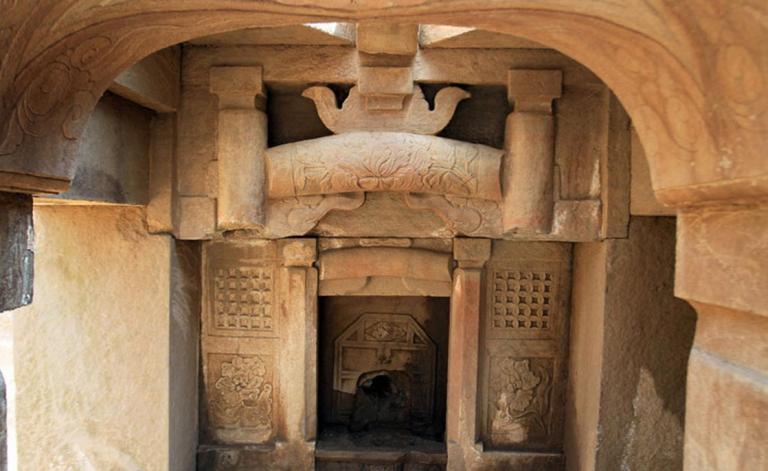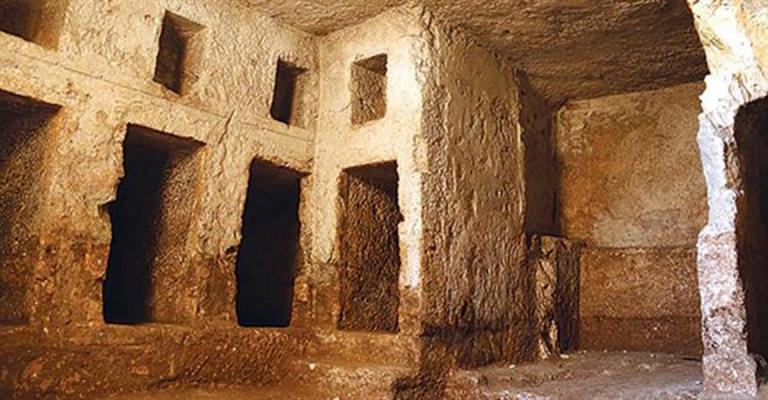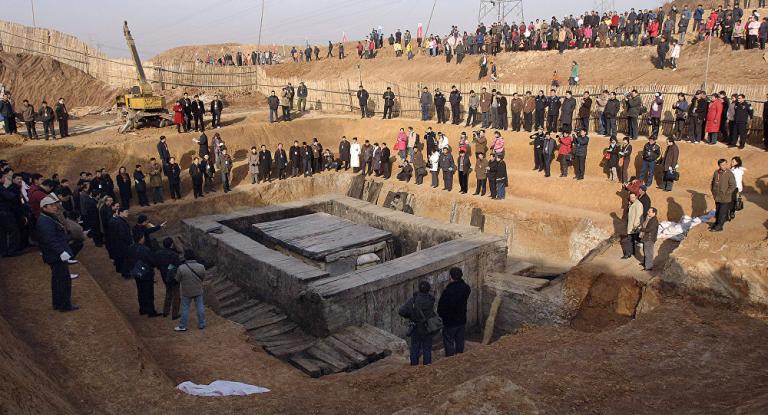Ancient Chinese tombs
6 min readConfucianism places great emphasis on filial piety, holding that if people respect their elders, they will not defy their superiors or resist authority. When respected elders were put to rest in their graves, they were thought to enter the world of the ancestors. Therefore, great importance was placed on the construction of tombs and mausoleums. The magnificent tombs of rulers were an expression of ancestor worship, and an important type of architecture Tombs consisted of an underground vault that held the remains of the deceased, covered by a large mound of soil. The Chinese ancestors believed that the towering mountains, great rivers tall trees and huge rocks of the natural world were invested with divine significance. This concept was incorporated into their architectural constructions. Great size represented dignity and importance, so the tombs of rulers were constructed on a correspondingly huge scale. The Chinese word for these monumental royal tombs literally means”lofty mountains.

Prior to the Spring and autumn and Warring States Periods (770-221 BC), graves were not covered with these huge mounds of soil. The tombs of the Shang Dynasty(1600-1046 BC) rulers consisted of huge underground burial chambers that held vast amounts of funerary objects such as chariots, as well as people and horses who were buried alive with the deceased ruler. There was no mound aboveground but merely a flat area with several halls and pavilions By the time of the Warring States Period(475-221 BC), many large tombs started to be covered with earthen mounds. One of the first known examples is the tomb of King Cuo of Zhongshan(c. 4th cen-tury BC), found in Pingshan, Hebei Province. Huge mounds remained an integral part of royal tombs through the Ming-Qing period (1368-1911 AD).
The grave mounds of the Qin-Western Han period(221 BC-9 AD) were square pyramids surrounded b walls. This form continued to be used through the Tang-Northern Song period (618-1127 AD). Under ground vaults containing large numbers of life-sized terracotta horses and warriors have been found in the vicinity of the famous tomb complex of Qin Shihuang, the first Emperor of the Qin Dynasty (r.221-209 BC). These figures are representations of the Emperor’s armies Han dynasty(202 BC-220 AD) tombs include aboveground roads known as”Sacred Ways, “lined on either side with stone watchtowers and stone carvings of mythological beasts .
Many tombs have been found dating from the Southern Dynasties(420-589 AD), most in the vicinity of Nanjing. These tombs are not covered with large mounds, but they do have Sacred Ways lined on either side with stone pillars, animals, and steles .
A Tang Dynasty(618-907 AD) tombs complex known as the Eighteen Imperial Tang Tombs was unearthed north of the Wei River on the Guanzhong plain, in central Shaanxi Province. Most of these tombs were dug into natural mountains, creating a sense of grandeur that could not be matched byartificial earthen mounds. Among them is Qianling, the tomb of Emperor gaozong (r 650-683 AD) and the female Emperor Wu Zetian (r 690-705 AD). The tomb is located seventy meters up the mountain high above the Sacred Way that leads to it. The mountain peak rises above it in the north, while Wei River runs through the plain in front of it to the south The Zhongnan and Taibai mountain ranges re cede into the distance on either side. The tomb complex reproduces the layout of the Tang capital city Square walls surround the tombs, echoing those that enclose the inner palace complex. The Sacred Way stretches beyond these walls to the south for three or four kilometers. The section closest to the tombs is lined with ornamental stone columns and stone carvings representing the emperor’s honor guard, including winged horses, engraved ostriches, horses being led by attendants, and people. Two sets of watchtowers and gates along the Sacred Way represent the gates to the imperial city and capital city, enclosing a large number of smaller, attendant tombs. The entire complex embodies imperial majesty and power.

The tombs of the Northern Song Dynasty(960-1127 AD) are concentrated in Gong County, Henan Province. They are similar to the Tang Dynasty tombs, but much smaller in scale Shisanling(the Thirteen Ming Tombs), is the most important Ming Dynasty (1368-1644 AD) tomb complex. It is located north of Beijing at the foot of Tianshou Mountain, in a broad horseshoe-shaped valley which opens to the south. Changling, the burial site of Emperor Zhudi (r 1402-1424 AD), is the principal tomb. It is located at the northernmost central point of the valley, at the base of the moun tain. About seven kilometers to the south, the massive Stone Memorial archway marks the start of the Sacred Way that leads to the tombs. One kilometer north of the Stone archway is the Great Red Gatethe entrance to the complex. Further along is the Stele Pavilion, which contains a number of stone memorial tablets. White marble pillars mark the four corners of the Stele Pavilion, further emphasizing its size. The Sacred Way continues north, lined on either side with numerous stone carvings. The Sacred Way ends in the north at three-arched stone gate, marking the beginning of the tomb complex proper. The entire route is laid out in accordance with the terrain, set against the backdrop of Tianshou Mountain rising behind Changling. Because the mountain range to the east of Tianshou mountain is relatively low, the Sacred Way is offset slightly to the east in order to produce a more balanced perspective.
The Changling tomb contains three courtyards of the same width, separated by gates. The first gate gives access to the simple outer courtyard, which has one stele pavilion on the east side. The second gate, Ling’ enmen Gate, is very similar to Taihemen Gate at the Forbidden City. Through this gate is the square second courtyard, which contains Ling endian(The Hall of Eminent Favor), an immense memorial hall similar to the Hall of Supreme Harmony in the Forbidden City. The hall is constructed on a three-tiered stone terraces surrounded by stone columns To the north of the hall stands the Inner Red Gate, which marks the beginning of the grave mound. The mound is circular and enclosed by a high wall similar to a city wall. On the mound’s central axis is a memorial archway a stone platform, and square watchtower known as the Soul tower.
Changling has two principal structures, the Hall of Eminent Favor in the front and the Soul Tower in the rear. The Hall of Eminent Favor is a rectangular wooden structure, while the Soul Tower is a tall vertical construction made of brick and stone. The contrast between the two is striking and leaves a lasting impression. The ancient pine and cypress trees throughout the grounds create an atmosphere of natural solemnity.
The remaining twelve tombs are distributed on either side of Changling in an arc that embraces the Sacred Way .
During the Qing Dynasty(1636-1911 AD), two royal tomb complexes were constructed near Beijing one to the east and one to the west .
Fengshui, or geomancy, refers to the process of harmonizing architecture with the natural environ ment. The concept of fengshui appeared as early as the Shang-Zhou period c 1600-256 BC), and had developed into a comprehensive system by the time of the Han-Wei period(202BC-266 AD). During the Jin-Tang period (265-907 AD), fengshui became an increasingly important consideration in the selection of burial sites, as recorded in a number of references including Zangjing(the Book of Burial)(c.276-324 AD). By this time, fengshui also had a major practical influence on all types of architecture Fengshui was divided into two main categories. The Situational School emphasized topographical considerations, including mountains and rivers, orientation, location, and surrounding environment The ideal configuration was considered to have a tall mountain peak to the north, to block the cold northern winter wind, and an open plain to the south, exposing the site to the warmth of the southernsun. At the heart of the construction was the mingtang, a central open area with an unobstructed view of the southern sky. In front of the mingtang there should be a smal flowing stream to provide watersupply and drainage. Beyond the stream to the south there should be a low hill to provide scenic con trast, with a higher range of hills in the distance to further enhance the layered effect of the scenery Low mountains should embrace the site on the left and right, creating an enclosed and sheltered environment. These requirements were all based on a comprehensive set of scientific and aesthetic principles
The Compass School selected architectural sites according to the time and date of the prospective o cupant’s birth Most of these considerations were based on superstition Both schools of fengshui held the unfounded belief that the location of graves and residences alike had a lasting influence on the fate of future generations.









